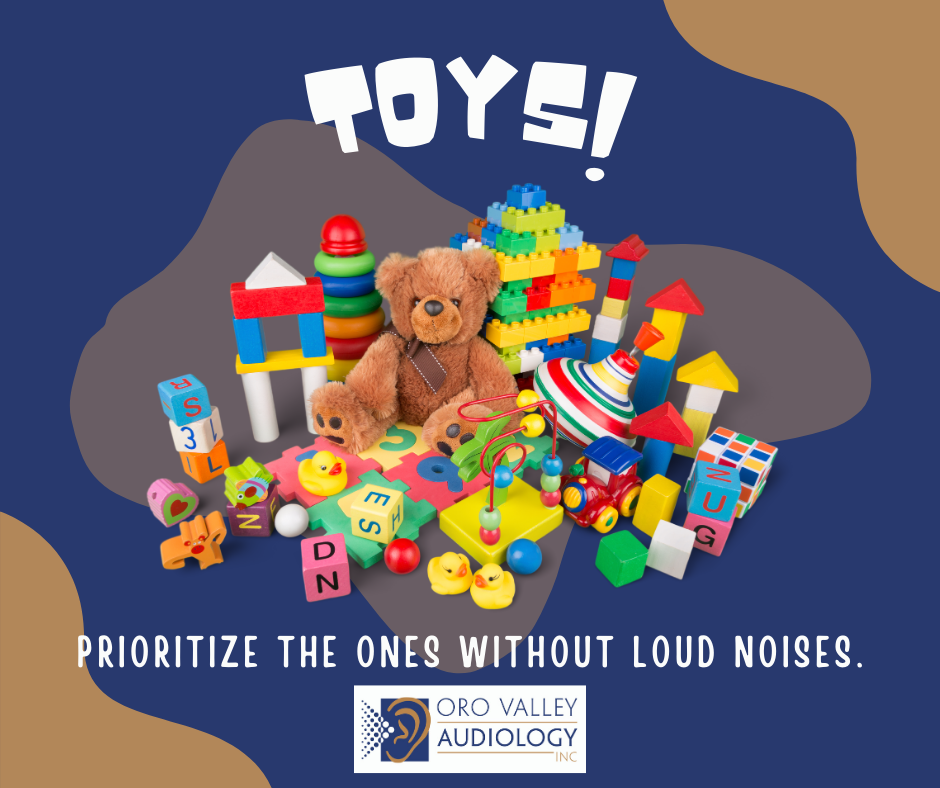It’s the holiday season once again. It seems this season comes around more quickly every year. This is the time of year for pumpkin bread, apple pies, and (in my family) homemade cinnamon rolls! It is also the biggest gift-giving time of the year. Since children are the most common recipients of gifts, toy sales go up significantly this time of year.
But, these same toys that bring joy to children can also harm them. This is why December is designated as “Safe Toy Month” – a reminder to ensure that kids are only given safe toys. When we think of toy safety, we often consider small parts that can be choked on, small batteries that can be eaten, or sharp parts which can cause lacerations. However, there is another area of safety which people often forget to consider: noise levels.
According to the Centers for Disease Control, exposure to loud sounds in childhood contribute to noise induced hearing loss in about 12.5% of 6-19 year olds in the United States. This means approximately 5.2 million children have hearing loss that could have been prevented, simply by avoiding loud sounds.
Did you know that hearing loss can occur after just one exposure to sounds of 120 dB or more? Did you also know that prolonged exposure sounds greater than 80 dB can also cause permanent hearing loss? Traffic noise, noisy restaurants, and even hairdryers are all often louder than 80 dB. Concerts, jack hammers, gun shots, and jet engines are loud enough to cause immediate hearing loss after a single, brief exposure. Car horns, motorcycles, yard equipment, and even ice cream truck noise levels fall between the 80 and 120 dB range as well. And, would you believe that there are many toys that fall into this range of loudness as well? We would like to think that toy manufacturers would do their best to limit exposure to such loud sounds for children’s toys, especially since children are not able to understand the risks of noise exposure. But, unfortunately, that is not the case.
A good general rule of thumb is that if the sound seems loud to you, it is likely too loud for your child. Also, a toy that is rated to be at non-damaging levels may still be damaging. Toys are typically tested for volume level at a toddler’s arm length away. However, kids often hold noise making toys right up to their ears. So, a toy that is only rated at 80 dB, may actually be nearly 100 dB when held near the ear.
Since so many children nineteen and younger have at least the beginning of permanent, noise-induced hearing loss, it is incredibly important to protect them during the phase of their life when we can still guide them into doing what is best for their health.. When purchasing toys for children, it is always wise to look over reviews from those who have purchased the product in the past. Look specifically for complaints of noise levels being too high. This is typically a good indicator that the sound level is too loud.
Every year near the holiday season, the Sight and Hearing Association releases testing information on sound levels of toys. We recommend looking this list over before purchasing any toy. If a child already has a toy which seems too loud, one option you have is to put packing tape over the speaker. As a mother, myself, I have even added layers of paper towel under the tape to reduce the volume of my daughter’s toys.
Most of the toys that we have been referring to are typically marketed for young children. However, older children have their own noisy toys to worry about – their tablets or smartphones. If your child is allowed to use smart devices with their own personal headphones, we strongly recommend researching for headphones or earbuds which have volume limiting features. It is also important to do research in order to double check that advertised volume limits are accurate and cannot be overridden. This will ensure the child cannot expose themselves to audio above certain levels no matter how much they try to turn up the volume.
A quick search online for volume limiting children’s headphones will turn up several. Though harder to find, volume limiting earbuds are also available (my daughter has a Bluetooth pair). When making a final decision about the best headphones for a child, keep in mind that the limiting volume level should be no more than 80-85 dB. Even with these volume restrictions, limiting the time the headphones are used to less than an hour per day can also help prevent noise-induced hearing loss.
If you or a loved one have concerns about your hearing, contact our office to schedule a hearing exam. If you are concerned that your child may have noise-induced hearing loss, please give us a call. We evaluate children, too! We at Oro Valley Audiology hope you have a wonderful holiday season and are able to spend time with those you love making memories that will last a lifetime.


